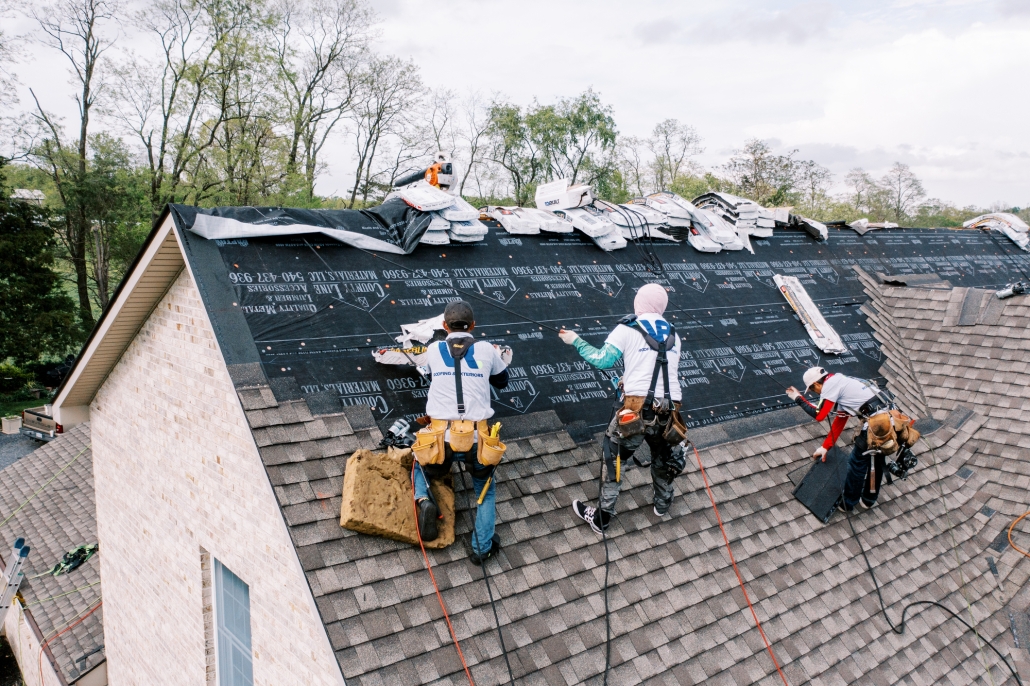Neighborhood Insights on Roofing Companies Gainesville Florida Homeowners Prefer
Wiki Article
Ideal Practices for Ensuring Appropriate Roofing Ventilation
A well balanced consumption and exhaust air vent proportion, generally 1:300, plays an essential function, with consumption vents preferably put at the reduced side of the roof for awesome air entrance and exhaust vents at the top for warm air leave. Maintaining insulation away from vents is critical to prevent airflow restriction.Understand Air Flow Fundamentals
Effectively recognizing air flow basics is vital for ensuring the durability and performance of roof. Efficient ventilation alleviates wetness buildup and temperature level extremes in the attic room, both of which can bring about significant architectural damage gradually. A well-ventilated roofing helps in preventing typical concerns such as mold growth, timber rot, and ice dams, which can endanger the stability of the roof products and the underlying structures.The primary goal of ventilation is to help with the movement of air, permitting for a consistent exchange in between the exterior and indoor environments. This equilibrium is accomplished through a mix of intake and exhaust vents that interact to maintain optimum airflow. Consumption vents, commonly situated along the soffits or eaves, enable fresh air to enter the attic room area, while exhaust vents, commonly positioned at or near the roofing ridge, allow warm, humid air to run away.
Key elements influencing the performance of roof covering ventilation include proper positioning, appropriate sizing, and making sure that both intake and exhaust vents are unblocked. Regular evaluation and maintenance are crucial to determine possible clogs, damages, or inadequacies in the air flow system, thereby guarding the roof's efficiency and toughness.
Kinds Of Roof Vents
Roof vents play a vital role in preserving reliable attic ventilation and, by expansion, the general wellness of the roofing system. Various kinds of roof covering vents are readily available, each with one-of-a-kind benefits tailored to particular roof covering needs. Ridge vents, for example, are installed along the roofing system's optimal, allowing cozy, damp air to get away from the attic. They use constant air flow and mix perfectly with the roofline, making them both effective and cosmetically pleasing.
Soffit vents are set up under the eaves and job in tandem with roof vents to make certain a well balanced intake and exhaust system. By permitting cooler air to go into from below, soffit vents assist in the expulsion of hot air with upper vents. Gable vents, situated on the exterior walls of the attic, deal another effective service, especially in homes with gable roofings.
Examine Your Current Air Flow

Next, consider the age and condition of your roof covering materials and ventilation parts. Older systems may not abide by existing building ordinance or may have weakened over time, reducing their efficiency. Conduct an extensive examination to recognize any type of signs of damage, such as rust, damages, or gaps that might compromise the system's performance.
In addition, measure the attic room temperature level and humidity levels. High temperature levels and moisture can indicate inadequate that site air flow.
Installment Best Practices
Efficient installment of roofing ventilation systems is extremely important for ensuring ideal efficiency and long life. Appropriate installment starts with understanding the particular air flow requirements of the structure and the roof it covers. This includes calculating the correct proportion of consumption to tire vents, typically adhering to the 1:300 guideline, which stipulates one square foot of ventilation for every 300 square feet of attic room floor space.
The positioning of vents is similarly essential. Intake vents need to be set up at the roof's reduced edge, typically in the soffits, to allow cool air to go into. Exhaust vents, on the other hand, should be installed near or at the roofing system's top to facilitate the departure of cozy, damp air. This develops a natural airflow that helps maintain temperature and dampness balance within the attic area.
Seal all vent links thoroughly to stop air leaks and possible water infiltration. Usage high-quality materials and adhere to maker standards to make sure toughness and efficiency. Furthermore, incorporating ridge vents with baffles can considerably enhance airflow effectiveness by preventing wind-driven rainfall and snow from entering the attic.
Ultimately, precise installment of roof covering air flow systems reduces prospective concerns such as mold growth, ice dams, and architectural damages, making certain the roofing's integrity and the building's total health.
Routine Upkeep Tips
Uniformity in maintenance techniques is basic to making certain the long-lasting performance of roof ventilation systems. Normal evaluations are crucial, preferably executed biannually-- in the spring and loss. Throughout these evaluations, make sure that vents are devoid of debris, nests, and other this article obstructions that might hinder air movement. Examine for any indicators of wetness build-up or mold and mildew, as these can indicate inappropriate air flow or leakages (roofing companies).
Utilize a soft brush or a vacuum cleaner to eliminate dust and particles from consumption and exhaust vents. Be cautious not to harm the vent screens or louvers throughout the procedure.
Correct insulation is equally important. Make certain that attic room insulation does not obstruct the vents, as this can seriously limit air movement. If any insulation has actually moved or resolved, reposition or replace it to preserve a reliable barrier.
Lastly, replace any damaged or missing out on components promptly. Busted vents, fractured shingles, or shabby blinking can all contribute to poor ventilation and should be dealt with without delay. Regular upkeep ensures that the roofing ventilation system functions optimally, therefore prolonging the life-span of the roof itself.
Verdict
Guaranteeing appropriate roof covering ventilation is paramount for preserving the effectiveness and sturdiness of a roof covering system. Adherence to the 1:300 consumption and exhaust vent proportion, combined with the calculated positioning of vents, is important.A well balanced intake and exhaust vent proportion, commonly 1:300, plays an essential role, with consumption vents ideally put at the reduced side of the roof for awesome air access and exhaust vents at the top for cozy air exit. Consumption vents, normally located along the soffits or eaves, allow fresh air to enter the attic area, while exhaust vents, usually situated at or near the roofing ridge, allow hot, damp air to get away.
Soffit vents are set up under the eaves and work in tandem with roof covering vents to guarantee a balanced consumption and exhaust system. By allowing cooler air to get in from below, soffit vents facilitate the expulsion of hot air via upper vents. Adherence to the 1:300 consumption and exhaust vent ratio, coupled with the tactical positioning of vents, is vital.
Report this wiki page